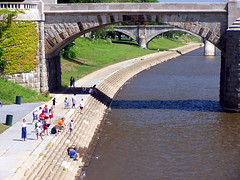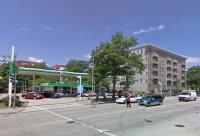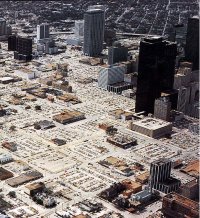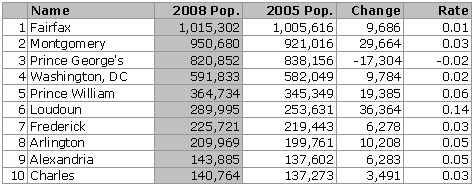|
Special Features





Image Libraries


|
|
Blog
Top 10 urbanist day trips
|

Residents of Harrisburg playing along the Susquehanna River waterfront. |
As a ridiculous city geek, one of my all time favorite things to do is to hit the road (or rails) on a Saturday, find some interesting city or neighborhood I’ve never visited, and explore it. Photograph the local architecture, have lunch at some hole in the wall cafe, check out the downtown shopping… loads of fun.
Living on the east coast offers a bountiful list of targets. Not only do we have lots of bona fide big cities in close proximity, but there are plenty of interesting smaller cities and towns in between. So here is the BeyondDC list of top day trips for urban exploration. To qualify, a destination has to be within approximately two hour travel time from DC (but outside our immediate metro area), and has to be an urban destination – I’m not talking about resorts or outlet malls here.
Before beginning, one quick note about the most obvious omission: Philadelphia does probably technically qualify, but it’s on the outer edge of our geography, and it’s too huge to really appreciate in one day. While it might be fun to hit South Street bars one night, if you’re out to get a sense of the city’s urbanism (the point of this exercise) then it is going to take more than one day to get out there, do your thing, and get back. So while Philly is a great town that deserves plenty of adoration, it’s off this list.
Number 10: Hagerstown
Like a miniature Baltimore, if Frederick is a miniature Washington. Hagerstown spent the first half of the 20th Century as Maryland’s number 2 city, and it’s got the bones of a place that feels like it could have been much bigger had things had worked out differently. Oh, and if you really want to outlet shop, you’re covered.
Number 9: Ellicott City
Tucked in a little canyon way out on the far side of Howard County there’s an adorable little main street, with no discernible residential town around it. It’s one of the weirdest things in Maryland. Ellicott is surprisingly substantial, and has one of the most awesome / terrifying independent toy stores you will ever find.
Number 8: Fredericksburg
Fredericksburg would be the result if a Bond villain hired a fleet of helicopters to transport Old Town Alexandria from inside the Beltway to a spot half-way to Richmond. It’s basically the same size and shape, except the main commercial street runs parallel to the river instead of perpendicular to it. And while you’ll have to venture into the suburbs for it, they have the closest Sonic to DC.
Number 7: Winchester
The main commercial center of colonial-era Northern Virginia. Nuff said.
Number 6: Harrisburg
A downtown with tall buildings, a river with gorgeous bridges, rowhouse neighborhoods, a state capitol, and a train station with plenty of traffic. What’s not to love?
Number 5: Charlottesville and Staunton
The former has one of the nation’s most successful pedestrian malls and most famously beautiful college campuses. The latter has an unbelievable stock of big 19th Century buildings and an incredibly unique train station. Throw in a stop at Monticello and you’ve got an architectural tour de force.
Number 4: Frederick
A worthy end to the wealthy corridor of neighborhoods and cities that begins with Georgetown and Northwest DC, Frederick is gorgeous and stately. And its creekfront is something you won’t find anywhere else in the region.
Number 3: Annapolis
Where did they test the baroque street grid before DC? Where can you find not only 18th, but 17th Century buildings? Where is the oldest still-used capitol building in the US? Annapolis is awesome. If you can find the streets that are less touristy, even more so.
Number 2: Richmond
I don’t care what anybody says, skyscrapers are cool. On top of them, Richmond has a great residential neighborhood (The Fan), an avenue that could rival any in DC (Monument Ave), and an absolutely magnificent train station (Main Street Station). Shockoe Bottom and Carytown are also worth a look.
Number 1: Baltimore
Even though Baltimore is a major city, since it’s both closer and smaller than Philadelphia you can see a big chunk of it in one day. Start downtown and pick a direction. You can even use transit.
Honorable Mentions: York, Harrisonburg, Leesburg, Martinsburg, Easton, Wilmington.
January 5th, 2010 | Permalink
Tags: top10

Top 10 regional bus agenciesHere are the 10 most heavily ridden bus agencies in the region, ranked by ridership according to APTA’s latest report:
- WMATA – 442,900 daily unlinked passenger trips
- Ride-On – 93,700
- Fairfax Connector – 32,000
- Dash – 13,800
- The Bus – 13,300
- Omni-Ride – 12,400
- DC Circulator – 9,000* (estimated; see note below)
- ART – 5,100
- CUE – 3,800
- Loudoun Transit – 3,600
* APTA’s report doesn’t include information for the DC Circulator. The 9,000 daily number is estimated from DDOT’s monthly report.
Bonus:
Ridership for the other large cities in Maryland and Virginia:
- Baltimore MTA – 279,200
- Hampton Roads Transit – 49,500
- Greater Richmond Transit – 33,500
It’s quite shocking how much lower the Virginia cities are. Even though they’re smaller metro areas, I’d at least expect the regional transit agencies of Hampton Roads and Richmond to carry as many people as Montgomery County’s bus system. Actually, Ride-On is very impressive. If you browse through the APTA document above you can see that it carries more people than the regional bus agencies in several large cities.
December 7th, 2009 | Permalink
Tags: top10, transportation

Top 10 missed Metro stations
|

14th and Euclid, NW. A perfect place for a Metro station. |
For years BeyondDC has been making the case that our region should be more open to transit modes other than Metrorail. Metro is great, but with its extremely high price tag and with over a hundred miles of it already in service, what our region needs most now is better network coverage. At this time, a billion dollars would be better spent on 10 new streetcar lines than one new suburban Metro extension, for example.
But that having been said, it’s still interesting to look at Metro’s missed opportunities. Considering its contemporaries, Metro is a shockingly well-planned system, but it obviously could have been better. So putting aside questions of maintenance, funding, operations, engineering, etc, and assuming the completion of the Silver Line, here are the top 10 remaining places we wish there were Metro stations. They generally fall into two categories: activity centers and dense walkable neighborhoods far from an existing station.
Number 10: Kalorama
Aka the Hinckley Hilton. Although you can get to this spot halfway between Dupont Circle and Woodley Park easily enough, the gap between those stations feels enormous. This is the sort of station that would make Metro more of an urban subway and less of a commuter operation.
Number 9: Cardozo
Same deal as Kalorama, except it’s more important at 14th and Euclid because of the escarpment between Clifton Street and Florida Avenue, and because the neighborhood isn’t as wealthy. There aren’t many places so near the regional core that a strip mall could have survived so long. It wouldn’t have if there were a Metro station nearby.
Number 8: Starburst
H Street will soon have a streetcar, lest the most isolated-from-Metro of the District’s neighborhoods would have to be higher on the list.
Number 7: Brightwood
The Georgia Avenue corridor is the city’s longest, and in some ways its most urban. A station at Brightwood would fill the long gap between Petworth and Silver Spring left by the Green Line’s sudden turn east.
Number 6: Langdon Park
There is a tendency to think of everything in the triangle between North Capitol Street, New York Avenue, and Eastern Avenue, NE as “Brookland” and call it a day. Actually, the Rhode Island Ave corridor is a lot like the Georgia Avenue corridor. A station at Rhode Island and 18th, NE would open up dozens of city blocks to the primary transit network, and drastically improve Rhode Island Ave itself.
Number 5: Old Town Alexandria
The only non-District location in the top 10, this one is kind of a no-brainer. Only the most dedicated pedestrians walk from King Street Metro, and that stupid fake trolley is just embarrassing, on top of being slow.
Number 4: Adams Morgan
One of the city’s biggest nightlife destinations as well as one of its most walkable neighborhoods. Adams Morgan is a natural. It might be even higher on the list if it weren’t already relatively easy to access from Woodley Park and Columbia Heights.
Number 3: Truxton / Bloomingdale
Too big, too dense, and too close to the core not to have a direct connection.
Number 2: Lincoln Park
The Orange/Blue tunnel serves the southern part of Capitol Hill very well, but leaves the central part uncovered. A station exactly at the midpoint of the Capitol, the Anacostia River, H Street, and the Southeast Freeway – that is, right at Lincoln park – would serve the entire greater Capitol Hill area. It would be the go-to station for at least 100 of the city’s most walkable blocks.
Number 1: Georgetown
Could number one on the list be anything else? Washingtonians have been lamenting the lack of a station in Georgetown for as long as I can remember, and for good reason. A Georgetown station would serve an area as large and walkable as Lincoln Park, and as much of a regional nightlife destination as Adams Morgan. It’s the perfect storm of transit want.
I still think that streetcars, BRT and improvements to commuter interurban rail would be a better investment at this time than expanding Metro, but if nothing else fun exercises like this can inform us about what gaps in the system need to be filled, via Metrorail or other modes.
Honorable Mentions: Historic Anacostia, Glover Park, Cathedral Heights, Logan Circle, BWI, Shirlington.
Cross-posted at Greater Greater Washington.
November 30th, 2009 | Permalink
Tags: top10, transportation

Top 10: Most offensive parking lots
|

Downtown Houston at the height of urban renewal. No way to build a city. |
Parking lots are the scourge of cities. They eat up valuable land that could be used for activity-generating purposes, and they spread development out so that walkable and transit-supportive densities aren’t possible. There are precious few things you can do to kill quality urbanism faster than introducing a bunch of parking lots.
Today, therefore, BeyondDC presents the top ten most offensive parking lots in the DC region. These are the lots that do the most damage to their environment. Each link leads to an aerial image of the lot in question.
Number 10: GWU Garage
DC’s height limit has long been a subject of much debate, but one of its indisputably positive effects has been that land downtown is at too much of a premium to waste on parking lots. As far as I’m aware, this is the only free-standing above ground parking garage downtown. At least the one above Union Station is an air-rights development.
Number 9: RFK Stadium
The only reason the acres and acres of asphalt at RFK aren’t higher on the list is that they’re basically out of the way. If they chopped up a neighborhood, they’d be worse.
Number 8: Pennsylvania Avenue at the Capitol
What a depressing end to what was supposed to be America’s finest street. How is it exactly that what should be one of the city’s prime corners is actually such a wasteland?
Number 7: Courthouse Plaza
One block from Court House Metro and smack in the middle of everything, this lot is a huge psychological barrier between the commercial and residential sections of Arlington’s Courthouse neighborhood.
Number 6: Nationals Stadium
Remember how Nationals Stadium was supposed to have awesome views of the Capitol dome? Remember how it was supposed to feel fully integrated with the surrounding city? Oops.
Number 5: Downtown Rockville
Like Courthouse but worse, because it’s *between* Metro and the most active part of downtown. Repeated attempts to redevelop this killer have fallen through.
Number 4: Capitol South
A full-block parking lot directly above a core Metro station, in one of the most historic and beautiful neighborhoods in the city? Really?
Number 3: Howard University
Usually where a major university fronts onto a major commercial street the result is a high-quality mixed-use neighborhood downtown. By any reasonable account, Georgia Avenue in front of Howard University should look like U Street. Instead, it’s an ocean of surface parking lots.
Number 2: Old Convention Center
The only reason this giant multiple-square-block scar on the urban fabric doesn’t top the list is that it’s been due to be redeveloped since day one.
Number 1: Union Station South
Who thought it was a good idea to put four square blocks of surface parking adjacent to one of America’s biggest transit centers, smack between that center and most of the activity it serves? Oh right, the Federal government. Congresspeople need their parking, after all. Thanks a lot, guys. :Facepalm:
Take a look at how many of the top 10 are the result of institutional decisions rather than free market ones. Without pulling a cadastral map and actually looking at ownership, I’d venture to guess that of these 10, only Courthouse and Rockville are the result of the market. All the others, every single one of these lots within the District of Columbia, is likely the result of governmental or quasi-governmental misuse. The market almost certainly would have seen all these properties developed productively years ago.
(Dis)Honorable Mention: Union Station north garage, King Street Metro, the Pentagon, the Natural History Museum.
October 22nd, 2009 | Permalink
Tags: top10, urbandesign

Top 10: Largest jurisdictionsLast week’s Top 10 TODs list was basically subjective. For today, how about something that can be supported using hard data:
Largest jurisdictions in the DC area, with growth since 2005

Interestingly, 20th Century sprawl champion Fairfax County – the only jurisdiction in the region with over a million residents – is now the slowest growing jurisdiction in the region, save for shrinking Prince George’s. A strong back-to-the-center movement is visible, as Arlington and Alexandria are both growing faster than any of the Beltway counties, and DC doing better than two out of the three. Even in real, non-percentage terms, more people moved into both Washington and Arlington than into Fairfax between 2005-2008.
Note: An earlier version of this post indicated that the District of Columbia was growing substantially faster. That information was incorrect. It didn’t reflect the 2006 census revision which increased the estimate for the District’s population. The census’ 2005 estimates page doesn’t indicate that the numbers are uncorrected, so I only discovered the error when checking against baseline data in the 2007 estimates. Apologies for any confusion or misdirected celebration.
October 6th, 2009 | Permalink
Tags: top10

Top 10: Best suburban TODs
|


Rockville (top) and Ballston (bottom), two of Washington’s best suburban TODs. |
How about a new feature for BeyondDC: The top ten list. You know the drill; I give a category and then ten good examples of things that are in that category. Everybody likes lists, right? Fun times.
I’ll be doing additional lists like this on the approximate schedule of “whenever I feel like it”, but there’s a lot of good fodder, so readers can definitely expect to see more.
For today, the Top ten suburban Transit Oriented Developments. The Washington region is famous for turning otherwise suburban areas around Metro stations into bustling urban downtowns. The following are the best of the lot. To qualify a neighborhood must be located outside the District of Columbia and must be within walking distance of a Metro station (preferably centered around one). Rankings are based on the quality of a neighborhood’s urbanism, measured subjectively according to the Three Ds theory. Size counts for something, but I’m looking more at urban quality. Number 10 is the tenth best in the region, number 1 is the best, etc.
Number 10: Crystal City
The quintessential mid-century Corbusian block of towers in the park, Crystal City is frankly awful (although the re-done Crystal Drive helps). Its saving graces are that despite pedestrian-unfriendly design, it’s got good density, a good mix of uses, and really good transit connections.
Number 9: Rockville
15 years ago Rockville probably wouldn’t have made the cut at all, but recent redevelopment has helped a ton. If they can ever redevelop that huge parking lot in the middle and improve the connection from Metro, Montgomery County’s seat of government could shoot up the list.
Number 8: Silver Spring
Strong urban pedigree and almost limitless potential are held back by the insultingly anti-urban Discovery Building, which sits dead in the center of downtown and kills what should be Silver Spring’s best block. If you didn’t have to walk through such trash to get to the better parts, it would rank higher.
Number 7: Rosslyn
Sort of a Crystal City, but with enough skyscrapers and newer infill that it’s a lot more interesting. Check back in two years after the Central Place and 1812 North Moore redevelopments are complete, and Rosslyn will be a whole new city with a vastly superior center.
Number 6: Ballston
The western anchor to Arlington’s Orange Line TOD corridor (see numbers 7, 5 and 3) is more livable and has a better mix of uses than eastern anchor Rosslyn. Stuart Street and Welburn Square are great places. Unfortunately, too much of its retail is bottled up in that darn mall.
Number 5: Court House
The seat of Arlington’s government is smaller than Ballston or Rosslyn, but has a great urban room where Clarendon and Wilson Boulevards come together for two blocks, and has more comfortable, homey character than its larger cousins.
Number 4: Friendship Heights
Technically half inside the District, Friendship Heights is a smaller, more wealthy version of Bethesda (see below).
Number 3: Clarendon
Urbanistically the best of Ornjington, Clarendon has that mix of old and new buildings that’s rare on the Virginia side of the river. It’s also here that Arlington is best implementing the urban design lessons it learned during 20th century redevelopments elsewhere in the County, like the need for architectural diversity on the ground level and that setbacks help offset skyscraper shadows. Those lessons mean Clarendon not only has a good mix of old and new, but that its new is better than the new in, say, Ballston. It also has some excellent small-scale green spaces.
Number 2: King Street
Maybe it’s the DC-like height limit, the weird street grid, or the presence of so many rowhouses nearby, but for whatever reason the area around King Street Metro in Alexandria feels more like a bona fide downtown than any other place on this list. The massive redevelopment south of Duke Street isn’t as high quality as King Street itself, but it sure has added to the activity level.
Number 1: Bethesda
The architectural diversity and quality, the density and land use, the almost European-like tangled grid of streets, the direct un-cut connections to adjacent residential neighborhoods… Bethesda is the gold standard in just about every way. A great model for developers or planning departments looking to implement TOD elsewhere (pay attention, Tysons Corner).
Just missed the cut: Pentagon City, Braddock Road, Virginia Square, Wheaton.
September 28th, 2009 | Permalink
Tags: top10

|
Media





Site
About BeyondDC
Archive 2003-06
Contact
Category Tags:
Partners
|



















